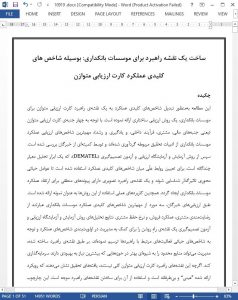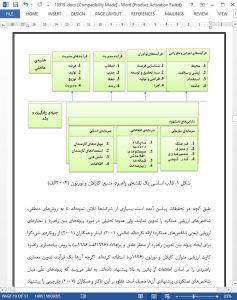Abstract
This study presents a structural evaluation methodology to link key performance indicators (KPIs) into a strategy map of the balanced scorecard (BSC) for banking institutions. Corresponding with the four BSC perspectives (finance, customer, internal business process, and learning and growth), the most important evaluation indicators of banking performance are synthesized from the relevant literature and screened by a committee of experts. The Decision Making Trial and Evaluation Laboratory (DEMATEL) method, a multiple criteria analysis tool, is then employed to determine the causal relationships between the KPIs, to identify the critical central and influential factors, and to establish a visualized strategy map with logical links to improve banking performance. An empirical application is provided as an example. According to the expert evaluations, the three most essential KPIs for banking performance are customer satisfaction, sales performance, and customer retention rate. The DEMATEL results demonstrate a clear road map to assist management in prioritizing the performance indicators and in focusing attention on the strategy-related activities of the crucial indicators. According to the constructed strategy map, management could better invest limited resources in the areas that need improvement most. Although these strategy maps of the BSC are not universal, the research results show that the presented approach is an objective and feasible way to construct strategy maps more justifiably. The proposed framework can be applicable to institutions in other industries as well.
1. Introduction
As a result of the global financial crises beginning in mid-2007, international stock markets have sharply crashed, and numerous enterprises have collapsed or have been bought out (Shah, 2009). Financial institutions in particular have encountered more competitive challenges worldwide during the chain effects of the financial ‘‘tsunami.’’ It is therefore imperative that banking institutions enhance their competitive advantages in order to outperform the numerous competitors in the industry. These institutions must place more emphasis on improving internal operational performance (Davis & Albright, 2004; Littler, Aisthorpe, Hudson, & Keasey, 2000). Banking institutions must develop an effective way to align their strategies with corporate goals on the basis of performance analyses. The structural analysis of an evaluation model that links strategic objects as effective improvement paths becomes a critical issue for banking institutions if they are to sustain their competitive advantages.
6.3. Future research
In summary, according to the conclusions and limitations ofthis study, the following suggestions are drawn to aid future research. First, since no one performance indicator fits all scenarios, future studies are suggested to tailor performance indicators to meet the organization’s overall goals as well as the objectives of each individual unit. Second, the results reveal that the KPIs of the BSC perspectives may not be mutually exclusive. That is, there exists some degree of interdependence among the KPIs. Other analytical techniques (e.g., fuzzy integral, Analytic Network Process) can be employed to solve the interactive and feedback relationships between the indicators and to further explore the relative importance among the KPIs. Finally, more cases and empirical studies are recommended as tools to validate the usefulness of the proposed model of establishing strategy maps in depth.











